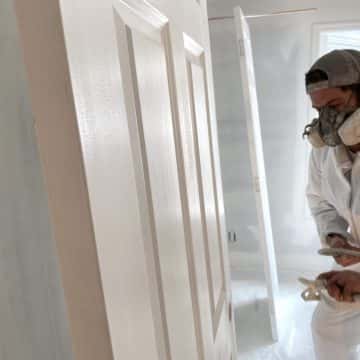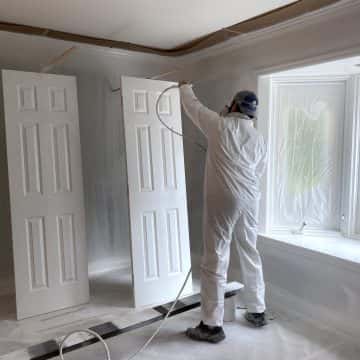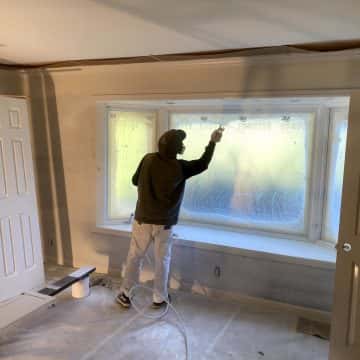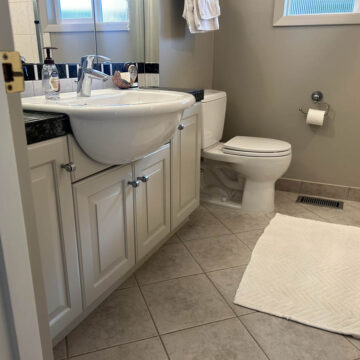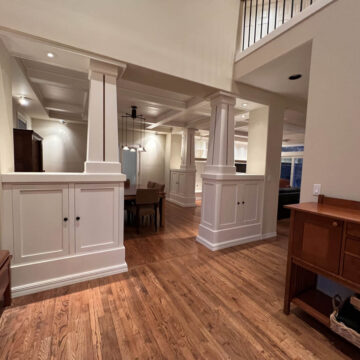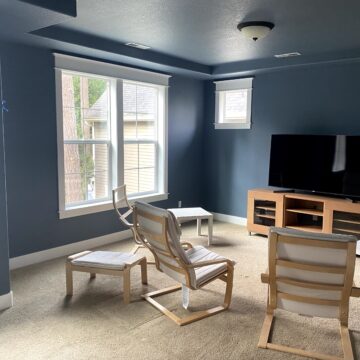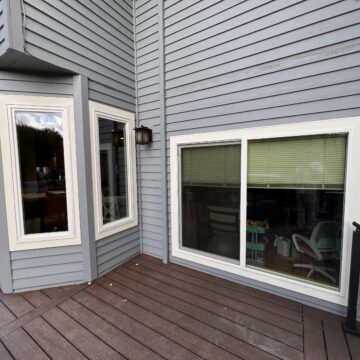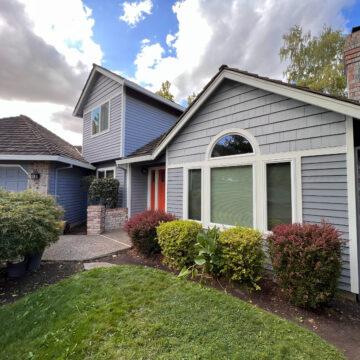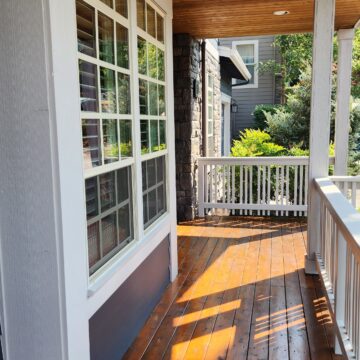The type of paint you choose when painting your home can significantly impact the final result both aesthetically and practically. There are three primary paint types: oil-based, water-based, and hybrid paints. While oil-based paints have been a longtime favorite for trim and cabinetry, they are slowly being replaced by more efficient and eco-friendly options. Water-based paints are now the standard for most home projects due to their ease of use and environmental benefits, while hybrid paints combine the best of both worlds, offering the durability of oil with the convenience of water-based options.
In this post, we’ll break down the pros and cons of each type, so you can make the best choice for your next painting project.
Oil-Based Paint
What is Oil-Based Paint?
Oil-based paint has been a staple in the painting industry for years, prized for its smooth, durable finish. It creates a hard, water-resistant surface that is especially useful for high-traffic areas like trim and cabinets. However, despite its excellent finish quality, oil-based paint has several drawbacks, which is why it’s being used less frequently today.
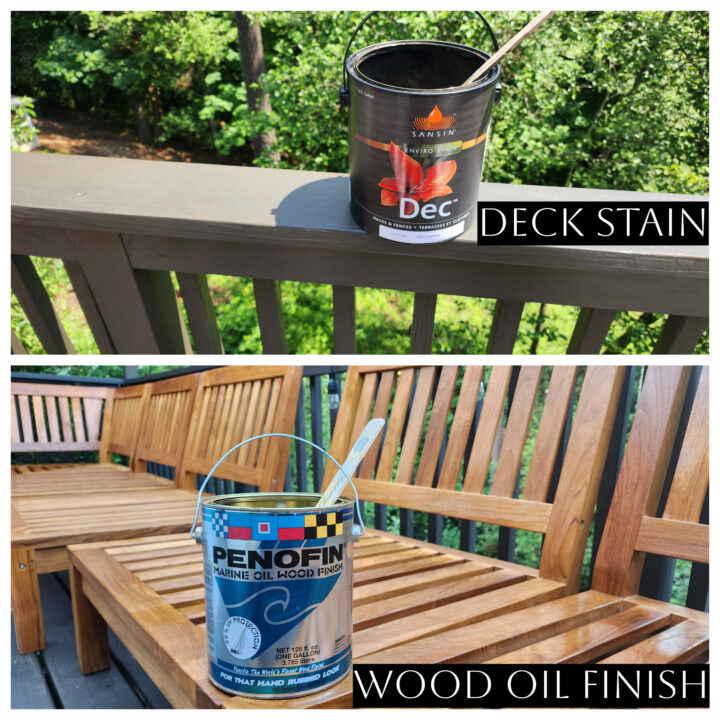
Pros:
- Durable and resistant to water.
- Creates a hard, smooth finish.
- Ideal for high-traffic areas.
Cons:
- Oil-based paints take 8-24 hours to dry between coats, adding time and labor costs to a project.
- These paints contain high levels of volatile organic compounds (VOCs), which produce strong odors and require good ventilation during application.
- One of the most frustrating downsides to oil-based paint is its tendency to yellow, especially in areas with limited natural light.
- While oil-based paints are durable, they can become brittle over time, which increases the likelihood of cracking or peeling if the substrate shifts or flexes.
- Cleaning brushes and tools requires harsh chemicals like mineral spirits or paint thinner.
When is Oil-Based Paint Used?
Despite its downsides, oil-based paint is still sometimes requested by homeowners who want that hard, glossy finish for their trim or cabinets and are insistent about the paint type. Often they have used oil-based paint for decades, or rely on outdated advice.
This is why we always make sure clients are fully aware of the maintenance and long-term effects of using oil-based paint.
Here’s a video that illustrates how oil-based paint yellows over time:
Water-Based Paint
What is Water-Based Paint?
Water-based paints, often referred to as acrylic or latex paints, have made tremendous advancements in recent years. This type of paint is the go-to choice for most home painting projects because they dry quickly, are easy to clean up, and have a much lower environmental impact than oil-based paints.
Pros:
- Most water-based paints dry within 1-2 hours, allowing for faster project completion.
- Soap and water are all you need to clean brushes and rollers after use.
- Water-based paints are much more environmentally friendly, with many options available that contain zero VOCs, making them safer for indoor use.
- Unlike oil-based paint, water-based paint maintains its original color over time.
- Water-based paints are more flexible than oil-based paints, which makes them less likely to crack over time.
Cons:
- While water-based paints are excellent for walls and ceilings, they may not be the best option for trim or cabinets that see a lot of wear and tear.
- Achieving the glass-smooth finish is harder with water-based options than with oil-based paint, though advances in formulations are closing that gap. This is why we often recommend hybrid paints for these uses.
When is Water-Based Paint Used?
Water-based paints are ideal for both interior and exterior projects. We often recommend them for walls, ceilings, and exterior siding. Some of our go-to products include Cloverdale Ecologic, Miller Evolution, and Benjamin Moore Regal for interior walls, as well as Cloverdale Cover Coat XL for exteriors. These paints offer excellent coverage, durability, and a smooth finish, without the environmental drawbacks of oil-based paints.
Hybrid Paint
What is Hybrid Paint?
Hybrid paints are a blend of multiple components, typically oil and water. We love them because they provide the look and feel of oil-based paint with none of the downsides.
A common hybrid that we use often is a waterborne alkyd. These paints use an oil-based resin suspended in water, resulting in a product that has the durability of oil-based paint but the ease of use and cleanup of water-based paint. It’s a great middle ground for projects that require a durable, smooth finish without the downsides of traditional oil-based paints.
Pros:
- Hybrid paints provide a finish that’s both hard and flexible, which means less cracking and peeling.
- Like water-based paints, hybrids don’t yellow over time, which is a significant advantage for maintaining the look of your trim or cabinetry.
- Most hybrid paints have low VOC levels, making them safer to use indoors.
- Unlike oil-based paints, hybrid paints are easier to touch up without visible discrepancies.
- Hybrid paints can be cleaned up with soap and water, just like water-based paints.
Cons:
- While faster than oil, hybrid paints may take a bit longer to dry compared to fully water-based options.
When is Hybrid Paint Used?
We recommend hybrid paints for high-traffic areas like trim, doors, handrails, and cabinets where you need durability but want to avoid the issues that come with oil-based paints. Some of our favorite hybrid products include Cloverdale Renaissance and Benjamin Moore Advance, both of which provide excellent durability and a beautiful finish. We’ve never had a coating failure with those products. We’ve also used Sherwin Williams Emerald Urethane, a urethane-modified acrylic, with great success.
Can you paint water-based on top of oil-based paint - and vice versa?
The short answer is no, you cannot paint water-based paint on top of oil-based paint. If you are in a situation where you need to paint water-based on a surface previously painted with oil-based, then the surface must be sanded and cleaned before adding a coat of an oil primer transition. At that point you can paint water-based paint on top of the primer.
Can you paint oil-based paint on top of water-based paint? Yes, you can. Ideally, you should sand and clean the surface first. A primer is not necessary.
Other Considerations When Choosing Paint Type
Interior Painting
For interior spaces like walls and ceilings, water-based paints are the best choice due to their low VOCs, quick drying time, and ease of use. However, for areas like trim, doors, or cabinets, a hybrid paint might be the way to go for that extra durability without the complications of oil-based paint.
Exterior Painting
When it comes to exterior painting, durability is key. Water-based acrylic paints are the best option for siding and walls, as they resist fading, peeling, and weathering. If you’re working on a project that involves doors or trim, a hybrid paint like Cloverdale Renaissance can offer the right balance of durability and ease of maintenance.
The only time we ever use oil-based products outdoors is with oil stain for fences and decks, or for metal gates and hand rails.
Ultimately, the choice of paint for your project depends on many factors and what is most important to you – whether it’s the durability and finish quality, drying time, ease of cleanup, or environmental impact. Each of these paints has its own strengths to consider. If you would like our professional opinion on which paint will work best for your project, leave a comment below or get in touch to discuss your next project.


